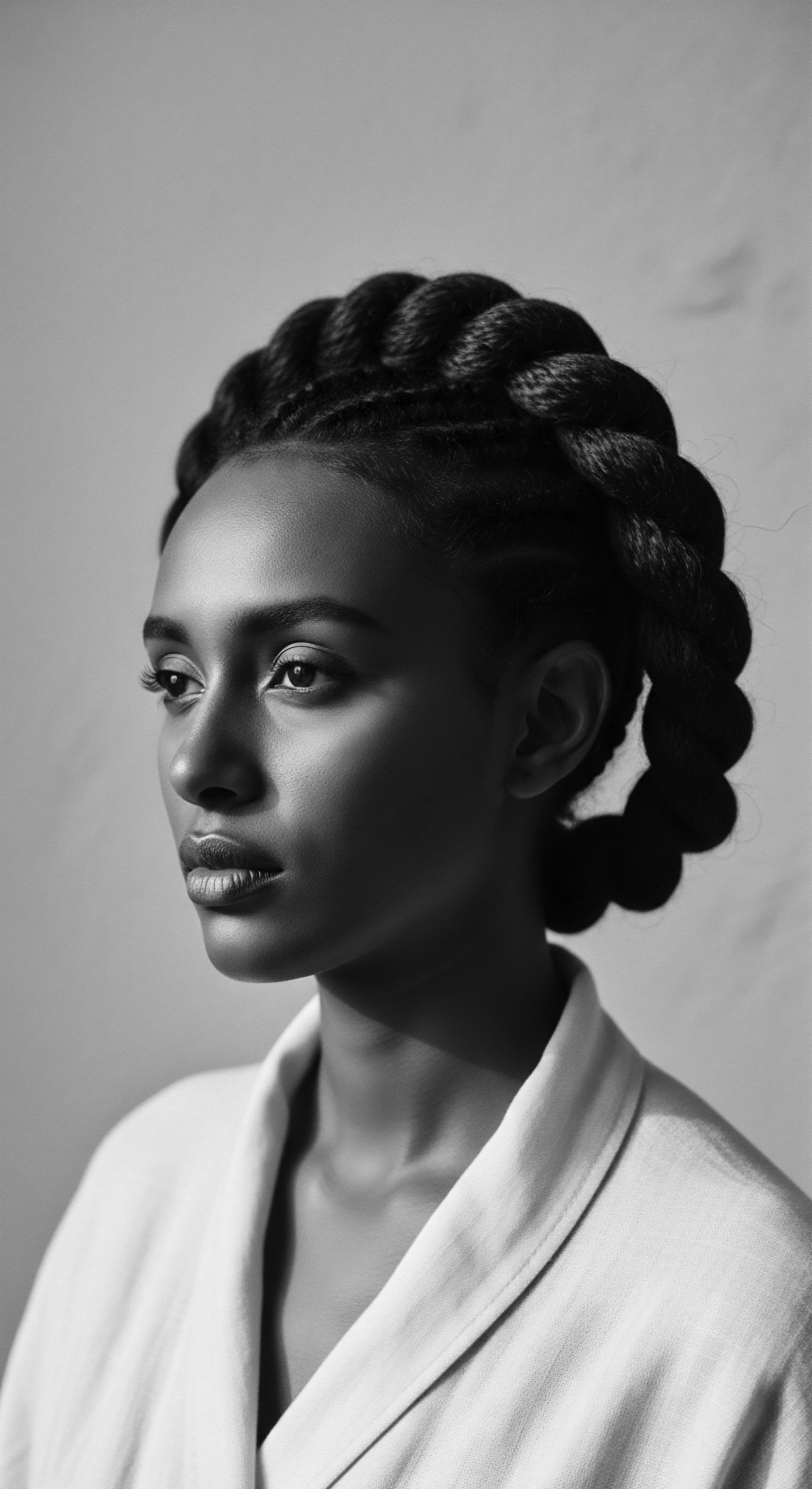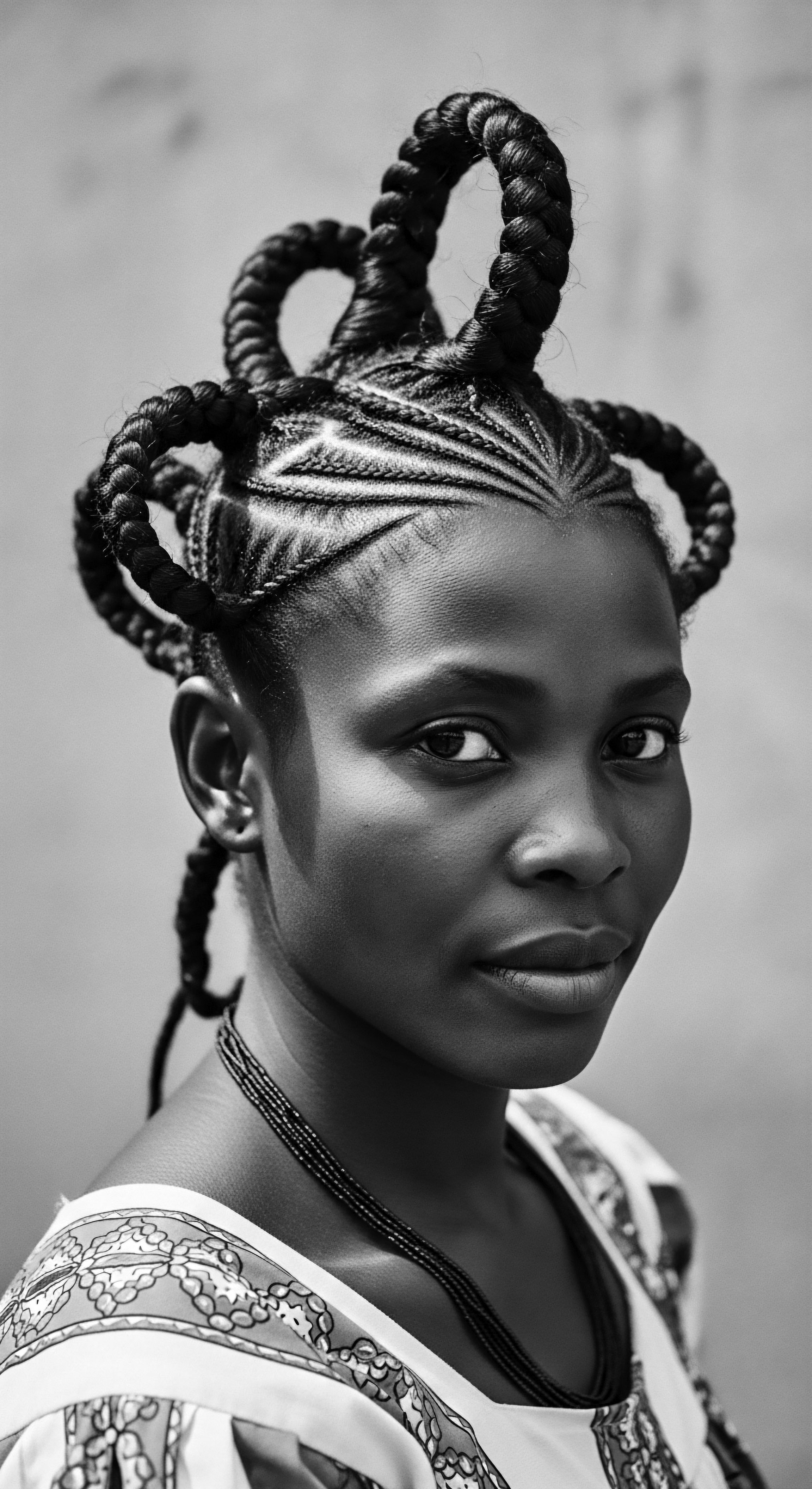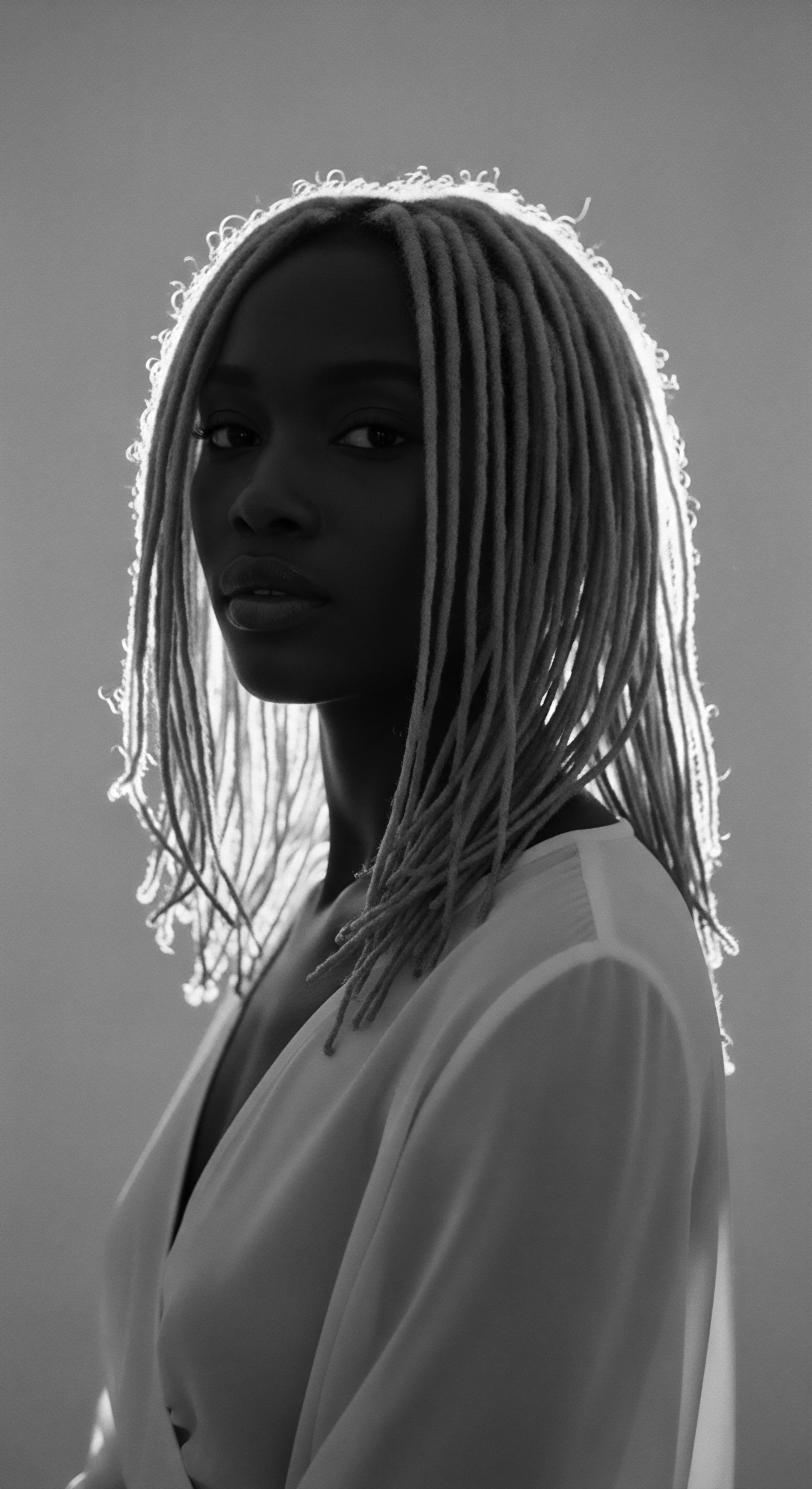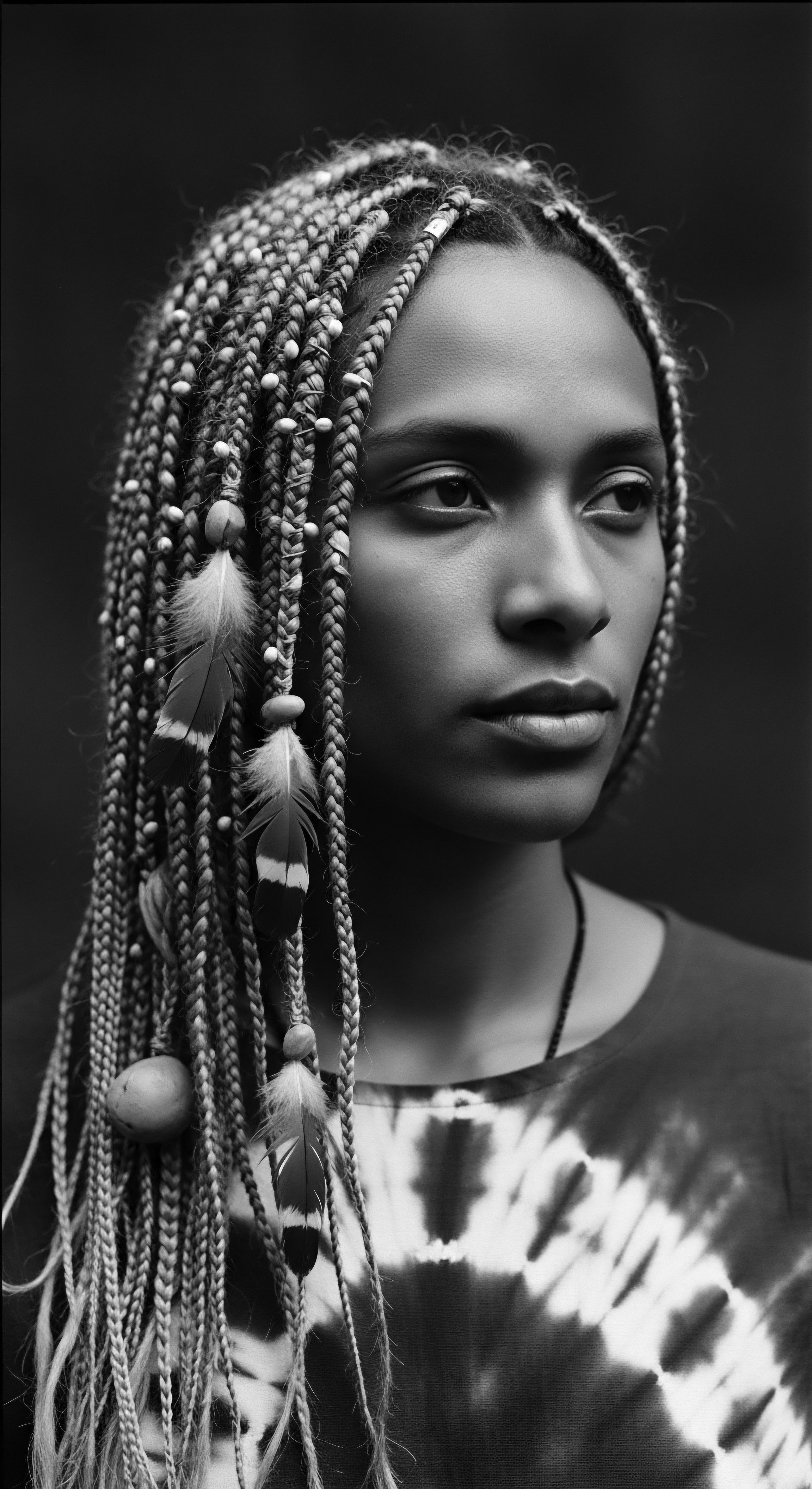
Roots
The story of textured hair, with its intricate coils, curls, and waves, is a narrative deeply entwined with human history and the wisdom of the earth. It is a chronicle of identity, resilience, and profound connection to ancestral practices. Before the vibrant hues of plant dyes graced a strand, there existed a natural palette within our heritage, one that saw hair not merely as biological fiber, but as a living extension of spirit and lineage. The cultural rituals accompanying historical plant dye use on textured hair are whispers from generations past, offering glimpses into societies where hair adornment was a sacred act, a declaration of belonging, and a vibrant expression of inner and outer worlds.
These traditions remind us that hair care was never a solitary, fleeting endeavor. It was a communal activity, passed down through the hands of elders, woven into the rhythms of daily life and ceremonial moments. The plants themselves—their leaves, roots, and flowers—were not simply sources of color; they were allies, imbued with medicinal properties and symbolic meanings. Understanding how these pigments interacted with textured hair, how they were cultivated and prepared, reveals a deep, scientific knowing held within ancient communities, a knowledge often overlooked in modern contexts.

Textured Hair Anatomy and Ancestral Wisdom
Textured hair, encompassing a spectrum from broad waves to tightly packed coils, possesses a unique helical structure, a biological blueprint distinct from straighter hair types. This distinction influences its interaction with moisture, its tensile strength, and indeed, its receptivity to natural pigments. Historically, communities understood these characteristics intuitively, long before microscopes revealed the elliptical cross-sections or the specific disulfide bonds.
They recognized the hair’s tendency towards dryness, its thirst for rich, emollient plant oils, and its magnificent ability to hold intricate styles. This inherent understanding informed the choice of plant dyes, which often served a dual purpose ❉ providing color while also conditioning and protecting the hair.
Consider the Himaba People of northern Namibia, for instance. Their practice of coating hair and skin with otjize paste, a mixture of red ochre and butterfat, serves as a powerful historical example. This paste provides not only a distinctive reddish hue, but also acts as a cleansing agent and offers protection against the harsh arid environment, shielding the scalp and strands from the sun.
This tradition illustrates how ancient practices harmonized aesthetic desire with practical necessity, deeply rooted in the ecological and cultural contexts of their land. The Himba’s ritual use of ochre highlights a continuity of practice where adornment and function are inseparable, honoring the physical and spiritual well-being of the individual within their ancestral environment.

How Did Earth’s Palette Color Ancient Hair?
The pigments of the earth—ochres, hennas, and indigos—formed the backbone of ancient hair dyeing. Each brought its own spectral gift and a unique relationship with the hair fiber. Ochre, an iron oxide pigment found in various shades of yellow, orange, and red, holds evidence of human use for over 200,000 years. Its application was not limited to hair, extending to body decoration, art, and even practical uses such as sunscreen.
In ancient Egypt, red ochre was used for lips and cheeks, connecting cosmetics to fertility and regeneration. For hair, it could impart a ruddy warmth, especially to darker strands, and was often mixed with fats or oils, which would have offered additional conditioning for textured hair types.
Henna (Lawsonia inermis), revered for millennia, stands as one of the oldest recorded cosmetic and hair dyes, its use dating back over 5,000 years in regions spanning North Africa, the Middle East, and South Asia. Ancient Egyptians, including figures like Cleopatra, used henna to achieve reddish-brown hues on their hair, even after death, signifying vitality. The plant’s lawsone molecule binds with the keratin in hair, creating a lasting stain that also imparts conditioning benefits. This deep interaction with the hair’s protein structure meant that henna not only colored but also strengthened the strands, a significant advantage for often fragile textured hair.
Indigo (Indigofera tinctoria), another profound botanical colorant, yielded deep blues and was often combined with henna to achieve darker browns or rich black shades. Its history is particularly rich in West African cultures, where its cultivation and use in dyeing were highly developed. The Yoruba, Manding, and Hausa peoples were renowned for their indigo processing, and the practice was often carried out by women who infused their work with spiritual guidance. This plant’s ability to create varying shades of blue, seen by classical Malian culture as encompassing at least twelve distinct variations, speaks to a sophisticated understanding of natural dye chemistry and cultural symbolism.
The hair, for many ancestral communities, was not just fiber; it was a conduit, a visible anchor to lineage and spiritual dimensions.
Beyond these prominent examples, a diverse array of plants offered their color to textured hair. Walnuts, turmeric, logwood, and even specific berries provided a spectrum of shades. The application of these dyes was deeply interconnected with social status, spiritual beliefs, and communal identity. In many ancient societies, hair color conveyed messages that transcended mere appearance, reflecting one’s position in society, religious affiliation, or personal achievements.
- Henna ❉ Ancient Egyptians used it for reddish-brown hues, a symbol of vitality.
- Ochre ❉ Applied by Himba people for red tones, offering cleansing and sun protection.
- Indigo ❉ Valued in West Africa for deep blues and blacks, with spiritual connotations.
- Walnut ❉ Provided dark brown to black shades in various ancient cultures.
| Plant or Mineral Source Henna (Lawsonia inermis) |
| Traditional Color Range Reddish-brown to auburn |
| Associated Textured Hair Benefit Conditioning, strengthening, cuticle smoothing |
| Plant or Mineral Source Ochre (Iron oxides) |
| Traditional Color Range Yellow, orange, red, brown |
| Associated Textured Hair Benefit Cleansing, sun protection, scalp soothing |
| Plant or Mineral Source Indigo (Indigofera tinctoria) |
| Traditional Color Range Deep blue, black (when combined) |
| Associated Textured Hair Benefit Adds depth, sometimes used for shine |
| Plant or Mineral Source Walnut Husks (Juglans regia) |
| Traditional Color Range Brown to dark brown |
| Associated Textured Hair Benefit Natural darkening, mild astringent for scalp |
| Plant or Mineral Source These ancestral ingredients served a dual purpose, adorning and nourishing textured hair. |

Ritual
The application of plant dyes to textured hair was rarely a solitary, utilitarian act. It was, more often than not, a profound ritual, steeped in symbolism and communal participation, a living testament to the deep reverence held for hair across diverse ancestral cultures. These rituals marked significant life passages, articulated social status, or served as protective blessings, connecting the individual to their community and the unseen world. The very process, from gathering the botanical ingredients to the final adornment, unfolded as a deliberate sequence, each step imbued with purpose.
Imagine the collective energy of a “Mehndi Night” in South Asian traditions, where henna is not only applied to hands and feet, but also incorporated into hair care preparations, often to mark a bride’s transition. These gatherings were joyous, filled with music, song, and dance, making the application of the dye a shared celebratory experience. This collective engagement reinforced community bonds and transmitted cultural knowledge from one generation to the next. The communal act of preparing the dyes and adorning one another was a tangible expression of care and connection, a tradition deeply etched into the fabric of many societies where textured hair thrives.

The Hands That Prepared, The Stories They Told
The preparation of plant dyes involved a sophisticated understanding of natural chemistry, passed down through oral traditions and practical demonstration. For indigo, specifically, the process was often laborious, involving the fermentation of leaves to extract the vibrant blue pigment. West African women, renowned for their expertise in indigo dyeing, sometimes sought guidance from the spirit world before initiating a new dye pot.
This speaks to the spiritual dimension inherent in these preparations—the belief that the plants held a life force, a soul, that imparted power and blessing along with color. The act of preparing the dye, grinding the dried leaves of henna or ochre, mixing them with water, oils, or even specific clays, was itself a form of meditation and connection to the plant kingdom.
Beyond the physical preparation, the ritual often encompassed a spiritual cleansing of the hair and spirit. Hair, considered by many Native American tribes to be sacred and an extension of the soul, held wisdom and connection to Mother Earth. Any adornment or coloring would naturally align with this profound respect.
For some Indigenous communities, specific families might paint their hair for ceremonies, with the colors and styles conveying tribal membership or familial distinction. These actions were not arbitrary stylistic choices; they were deeply meaningful expressions of identity and spiritual alignment.

Cultural Expressions Through Dye and Adornment
Plant dye use on textured hair frequently accompanied rites of passage, solidifying an individual’s place within their community.
- Initiations ❉ In some African cultures, the application of specific colored ochres or indigo pastes during initiation ceremonies marked a transition from childhood to adulthood, signaling new responsibilities and status.
- Marital Status ❉ For instance, in some parts of the ancient world, a woman’s hair color or adornment could indicate her marital status, wealth, or social role. The vibrant hues of henna on a bride’s hair in South Asia or the Middle East symbolize prosperity and blessings for marriage.
- Mourning Practices ❉ In contrast, hair could also be altered in times of mourning. Certain Native American tribes would cut their hair as part of a grieving process, a deliberate act symbolizing loss and connection to the spirit world. While not always involving dye, these acts demonstrate the profound symbolic weight carried by hair and how its alteration served ritualistic purposes.
The symbolism extended beyond life events. Color itself held cultural meanings that influenced dye choices:
From the earth’s very pigments, ancient hands transformed simple plant matter into powerful symbols of belonging, protection, and identity.
In traditional Yoruba chromatography, indigo, often perceived as a shade of black, carries meanings associated with the earth, fertility, and deep knowledge. These associations would undoubtedly shape the ritual context of its application, perhaps symbolizing grounding or connection to ancestral wisdom. Similarly, red ochre, evocative of blood and energy, represented life, death, and rebirth in ancient Phoenician burial rites.
When such a color was applied to hair, it carried these profound layers of meaning, transforming an individual’s appearance into a living cultural statement. The choice of plant pigment was a conscious decision, reflecting spiritual beliefs, social standing, or tribal affiliation.
| Cultural Context Ancient Egypt |
| Plant Dye or Pigment Henna |
| Ritual Significance Symbol of beauty, vitality, divine favor (Isis association) |
| Cultural Context West African Tribes (e.g. Himba, Yoruba) |
| Plant Dye or Pigment Ochre, Indigo |
| Ritual Significance Social status, protection, spiritual connection, cleansing |
| Cultural Context South Asian / Middle Eastern (e.g. Indian, Arab) |
| Plant Dye or Pigment Henna |
| Ritual Significance Bridal rites, celebrations, blessings, fertility, good fortune |
| Cultural Context Native American Tribes |
| Plant Dye or Pigment Various plants and minerals (e.g. ochre, yucca root) |
| Ritual Significance Ceremonial adornment, identity markers, connection to spirit, mourning |
| Cultural Context These rituals highlight how plant dyes transcended mere aesthetics, serving as conduits for cultural expression. |

Relay
The whispers of ancestral practices, the profound rituals of plant dye use on textured hair, do not merely reside in history’s annals. They echo into our present, offering a powerful relay of wisdom that bridges the ancient and the modern. This ongoing conversation between past and present allows us to deepen our understanding of hair care, moving beyond superficial remedies to a holistic appreciation rooted in heritage and scientific insight. It is a dialogue that seeks to validate long-standing traditional knowledge through contemporary understanding, recognizing that our ancestors were adept natural scientists in their own right.
Modern science, for instance, has begun to validate the conditioning attributes of traditional plant dyes. Henna, beyond its coloring capabilities, contains natural agents that coat the hair shaft, contributing to strength and shine. This explains why traditional applications often resulted in not just a vibrant hue, but also hair that felt resilient and healthy. The scientific explanation of lawsone binding to hair keratin confirms the efficacy observed for centuries, connecting the ancient practice to a cellular understanding.
Similarly, the use of substances like ochre, traditionally applied with fats, provided a protective layer. Science today recognizes the benefits of lipid layers for preserving moisture and elasticity in textured hair, qualities intuitively understood and applied by ancestral communities.

What Does Modern Science Reveal About Ancient Dyes?
The molecular interaction of plant pigments with the unique structure of textured hair offers fascinating insights. Textured hair, characterized by its elliptical shape and diverse curl patterns, presents a different surface area and cuticle structure compared to straight hair. Plant dyes, unlike many synthetic counterparts, typically deposit color on the outer layer of the hair shaft, or gently within the cuticle, rather than deeply penetrating the cortex. This means the color imparted often results in softer, more dimensional tones that shimmer with light, rather than a flat, uniform coverage.
This surface deposition also contributes to the conditioning benefits. The natural compounds in plants like henna do not strip the hair of its natural oils; instead, they can create a protective barrier.
- Lawsone (Henna) ❉ This molecule binds to the keratin protein in the hair, offering a strengthening effect alongside color.
- Indigoferin (Indigo) ❉ While primarily a dye, traditional indigo preparations, often involving fermentation, also contained beneficial compounds from the plant that could condition the scalp.
- Plant Tannins and Flavonoids ❉ Present in many plant dyes (like walnut husks), these compounds possess antioxidant and antimicrobial properties, contributing to overall hair and scalp health.
The absence of harsh chemicals found in many modern synthetic dyes meant that ancestral practices often preserved the integrity of the hair’s natural protein structure. This preservation is especially beneficial for textured hair, which can be more prone to dryness and breakage due to its structural characteristics.
The enduring legacy of plant dyes on textured hair is a vibrant testament to ancestral ingenuity, a bridge between botanical science and sacred ceremony.

How Do Ancestral Wellness Philosophies Inform Hair Health Today?
The holistic influences on hair health, deeply embedded in ancestral wellness philosophies, transcend mere aesthetics. For many cultures, the health of one’s hair was seen as a reflection of internal balance, spiritual alignment, and connection to the environment. This perspective encourages a care regimen that addresses the entire being, not just the hair strands.
Consider the broader implications of ancestral plant dye rituals:
- Connection to Nature ❉ Sourcing plants directly from the earth fostered a deep respect for natural cycles and the bounty of the land. This practice counters the detachment often experienced with mass-produced synthetic products, encouraging a mindful engagement with ingredients.
- Communal Care ❉ Many dyeing rituals were communal events. This fostered social connection, shared knowledge, and mutual support, elements vital for holistic well-being that extend beyond hair care itself.
- Mindful Application ❉ The traditional preparation and application of plant dyes often involved patience and a deliberate slowness. This mindful approach transforms a routine task into a meditative practice, reducing stress and promoting a sense of calm.
The resurgence of interest in natural hair care, particularly within Black and mixed-race communities, reflects a reclamation of this ancestral wisdom. It is a conscious choice to honor genetic heritage and historical practices, moving towards products and routines that are aligned with the body’s natural rhythms. This alignment extends to addressing common textured hair concerns. For instance, traditional remedies for scalp health, often involving herbal infusions or plant-based pastes, align with modern understandings of microbiome balance and anti-inflammatory properties.
The transition from historical practices to contemporary hair care is not a linear progression, but rather a spiraling return, enriched by new scientific insights. The wisdom of our ancestors, preserved in these ritualistic applications of plant dyes, provides a robust framework for building personalized textured hair regimens today—regimens that honor the hair’s unique biology while respecting its profound cultural and spiritual significance. It is a continuous relay of knowledge, from ancient hands to modern hearts, all for the enduring health and heritage of textured strands.

Reflection
The journey through the cultural rituals accompanying historical plant dye use on textured hair reveals a legacy far grander than mere surface alteration. It unveils a profound and interwoven story of humanity, the earth, and the intricate helix that graces our heads. Each application of ochre, each preparation of henna, each ferment of indigo, was a conversation ❉ a dialogue with nature, a communion with community, and a declaration of self within a rich, ancestral stream. These practices were not fleeting trends, but pillars of identity, resilience, and sacred connection, speaking volumes about the ‘Soul of a Strand’—the enduring spirit held within every curl and coil.
In the present, as we seek authenticity and connection in a world too often driven by the ephemeral, these historical echoes serve as a guiding light. They prompt us to look beyond quick fixes and superficial beauty, inviting us into a deeper relationship with our hair, one that honors its heritage. The botanical bounty that once adorned and sustained ancient textured hair continues to offer its gifts, awaiting those who seek to understand its wisdom. Our task, then, is to preserve these narratives, to respect the ingenuity of those who came before us, and to carry forward the luminous tradition of care, ensuring that the legacy of textured hair, its history, and its rituals, remains vibrant for generations to come.

References
- Abou-Zeid, M. M. (2022). Recent Advancements in Natural Plant Colorants Used for Hair Dye Applications ❉ A Review. Molecules, 27(23), 8565.
- Batterberry, M. & Batterberry, A. (1977). Fashion ❉ The Mirror of History. New York ❉ Greenwich House.
- Cleverman. (2024). The cultural significance of hair color ❉ A journey through history.
- Curationist. (n.d.). Hair and Makeup in Ancient Egypt.
- Divine Threading and Lash Studio. (2024). The Intricate Art of Henna ❉ Unlocking the Beauty and History of this Ancient Tradition.
- Encyclopedia.com. (n.d.). Hair Coloring.
- EyeFeather.com. (n.d.). The Spiritual Meaning of White Streak in Hair.
- Morocco World News. (2021). Henna ❉ History, Uses, Benefits, Symbolic Importance.
- Reshma Beauty. (2024). The History and Cultural Significance of Henna in Hair Coloring.
- RMIT Open Press. (n.d.). Colour to dye for ❉ how much do we really know about the risks of colouring our hair?
- RMIT Open Press. (n.d.). Colour dyes ❉ a (very) short history of dyes from around the world.
- Shunji Matsuo Singapore Premier Japanese Hair Salon & Expert Haircuts. (2024). A Hairy Tale of the Past ❉ Hair Dye Through the Ages.
- Sister Sky. (2019). The Significance Of Hair In Native American Culture.
- St Thomas University. (n.d.). Henna ❉ It’s History and Cultural Significance.
- The Trichological Society. (n.d.). Natural Hair Colour – Pigmentation.
- Tatter. (n.d.). Beyond the Blueness.
- Tatter. (n.d.). Personal Origin In Materials.
- Bebrų Kosmetika. (2025). Hair in Ancient Civilizations ❉ From Mesopotamia to Rome.
- Cornell Botanic Gardens. (2024). Indigo ❉ plant of culture and color.
- Discover Magazine. (2018). What the Ancient Pigment Ochre Tells Us About the Human Mind.
- ResearchGate. (n.d.). Ochre use and hair treatment among the Hamar (Ethiopia) ❉ An ethnoarchaeological approach.
- The Thread. (2020). Red Ochre ❉ The Colour of Survival.
- L’Oréal. (2023). The Importance of Indigenous Hair In Native Culture.
- Artisan Hair Cary. (2020). Hair Dye History ❉ Crazy Ways Ancient People Colored Their Hair.
- Reddit. (2014). Dyeing hair with plants, flowers, roots? (X-post fancyfollicles and fantasywriters).
- Brooklyn Museum. (2023). Uncovering a Women’s History of African Indigo.
- Sachi Skin. (n.d.). Let’s Talk ❉ A Head Full of Henna.
- CBC News. (2015). Aboriginal hairstyles express culture, pride and identity.
- Artisan Hair Cary. (2020). When Was Hair Dye Invented? A Fascinating Journey Through the History of Hair Colouring.
- Christine Shahin. (n.d.). Earthy Dyes – Goddess Beauty.
- Sue James. (2022). The Magic and Folklore of Hair by Sue James.
- Wikipedia. (n.d.). Ochre.
- Natural Pigments ❉ Sustainable Beauty with Skincare Benefits. (2024).
- Google Patents. (n.d.). CN106854383B – Natural pigment for dyeing black hair and composition thereof.
- Native American Natural Dyes ❉ A Guide to Traditional Colors and Techniques. (n.d.).
